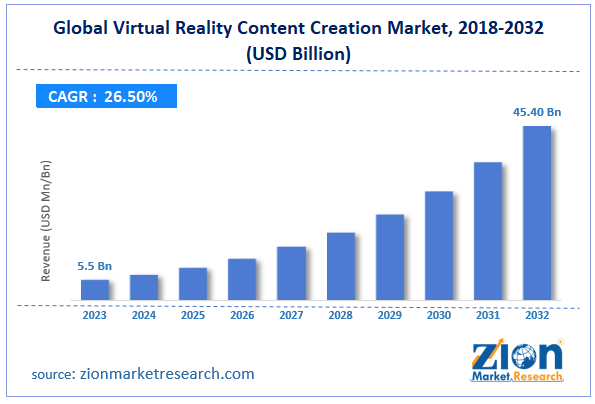Introduction
The Virtual Reality (VR) content creation market refers to the industry segment involved in the creation of immersive digital content for virtual reality experiences. VR content can be created for various applications, including entertainment (gaming and movies), training, education, healthcare, architecture, marketing, and tourism. As VR technology continues to evolve, it opens up new avenues for content creators to develop engaging, interactive, and visually immersive experiences.

The growing adoption of VR technologies, advancements in hardware and software, and increasing demand for immersive experiences across industries are driving the growth of the VR content creation market. This article delves into the key trends, drivers, segmentation, market dynamics, and regional analysis of the VR content creation market.
Market Dynamics
Drivers
- Rising Demand for Immersive Entertainment: The gaming and entertainment industries are major drivers of VR content creation. VR games, movies, and immersive experiences are gaining traction among consumers, with major companies investing heavily in content development to enhance user experiences. The rise of VR gaming platforms and the launch of VR headsets by companies like Oculus (Meta), HTC Vive, and PlayStation VR are accelerating the market’s growth.
- Advancements in VR Hardware and Software: Continuous innovations in VR hardware, such as high-definition VR headsets, motion-tracking devices, and haptic feedback systems, enhance the overall immersive experience. Additionally, advancements in VR software, including real-time rendering engines, 3D modeling tools, and content creation software, are enabling creators to produce more realistic and interactive VR content.
- Applications in Training and Simulation: VR is increasingly being used for training and simulation purposes across various sectors, including healthcare, military, aviation, and industrial operations. VR content creation for training modules, such as surgical simulations, flight simulations, and safety drills, is a growing segment in the market. The ability to create realistic and interactive environments for training and skill development is driving demand for VR content creation.
- Expanding Use of VR in Education: Virtual reality has found its place in education, offering immersive learning experiences that go beyond traditional classroom settings. VR content creation is increasingly used to create virtual campuses, historical reenactments, and science experiments, which allow students to engage with educational content in a more hands-on and interactive manner.
- Healthcare Applications: In healthcare, VR is used for patient treatment (such as in physical rehabilitation, pain management, and mental health therapies) as well as in surgical training and planning. The increasing use of VR in these applications requires sophisticated content creation that simulates real-world scenarios and therapeutic environments.
- Growth in AR and VR Integration: The convergence of Augmented Reality (AR) and Virtual Reality (VR) is creating new opportunities for content creators. Mixed Reality (MR), which combines both AR and VR, is becoming more prevalent, and content creation for these integrated experiences is gaining traction.
Request free sample: https://www.zionmarketresearch.com/sample/virtual-reality-content-creation-market
Restraints
- High Development Costs: Creating high-quality VR content requires substantial investments in both hardware and software. Specialized equipment such as 3D cameras, motion capture systems, and high-performance computers can drive up the development costs. As a result, many small and medium-sized content creators may face challenges in terms of affordability and accessibility.
- Technical Limitations and Performance Issues: Despite advancements, VR content creation still faces technical challenges such as latency, resolution issues, and rendering complexities. Achieving seamless performance with ultra-high resolution and minimal lag in immersive VR experiences is a significant challenge, particularly for real-time content.
- Limited Consumer Adoption: While VR technology has grown in popularity, mass consumer adoption remains limited due to the cost of VR headsets, space requirements, and technical complexity. Until VR technology becomes more accessible and widespread, the market for VR content creation may continue to face barriers.
- Content Fragmentation: As VR technologies evolve, content creators must ensure their work is compatible with multiple VR platforms (e.g., Oculus Rift, HTC Vive, PlayStation VR, etc.). The lack of standardization across devices can make content creation more complex and lead to content fragmentation, affecting its reach and user experience.
Opportunities
- Growth in Corporate Applications: Many businesses are incorporating VR technology for product design, virtual meetings, virtual storefronts, and marketing campaigns. The use of VR in advertising, real estate, and other business applications is opening up new avenues for content creation that goes beyond entertainment.
- Emerging Markets in Asia Pacific: The Asia Pacific region, especially countries like China, Japan, and South Korea, is experiencing rapid growth in the VR market, driven by the region’s tech-savvy population, increased investments in VR infrastructure, and a rising number of VR content creators. This presents opportunities for growth in VR content creation in these regions.
- Enhanced Social VR Experiences: Social VR experiences, such as virtual social platforms, VR chatrooms, and virtual reality events, are emerging as key applications. These immersive, social experiences open up new opportunities for content creators to develop environments where users can interact, collaborate, and engage in virtual activities.
- 5G Technology and Improved Connectivity: The widespread rollout of 5G technology is expected to enhance the delivery of high-quality VR content by reducing latency, increasing download speeds, and improving the streaming of VR experiences. This technological advancement will significantly benefit VR content creators and users alike, particularly in mobile VR experiences.
Market Segmentation
The VR content creation market can be segmented based on content type, industry application, platform, and region. Below is a detailed breakdown of each segment:
By Content Type
- 360-Degree Videos: One of the most popular forms of VR content is 360-degree videos, which allow users to experience an environment in all directions. These videos are widely used in tourism, entertainment, and education.
- Interactive 3D Environments: Interactive 3D environments are immersive VR simulations where users can interact with objects or scenarios. These are commonly used in gaming, training, and simulation applications.
- VR Games: Virtual reality gaming is one of the most dynamic and rapidly expanding areas of VR content creation. Game developers create immersive, interactive VR games that allow players to engage with the virtual world in real time.
- Simulation-based Content: VR content for simulations, including medical training, military exercises, and flight simulations, is in high demand. This type of content creation requires highly realistic and interactive scenarios.
- Others: This includes VR content for social media, marketing, real estate, and more. The demand for content creation in these sectors is growing as companies use VR to offer immersive experiences for their customers.
By Industry Application
- Entertainment & Gaming: The entertainment and gaming industry remains the largest market for VR content creation. VR gaming has witnessed substantial growth with the advent of advanced VR headsets and gaming platforms.
- Healthcare: VR is revolutionizing healthcare, both as a tool for training medical professionals and for patient treatment, including pain management, mental health therapy, and physical rehabilitation.
- Education & Training: Virtual reality in education is gaining traction as it offers immersive learning experiences. From virtual classrooms to interactive lessons, VR is transforming traditional education methods.
- Real Estate: VR is increasingly being used in real estate for virtual property tours, architectural visualization, and design planning, offering a unique, immersive way to experience properties before purchase.
- Retail & Marketing: VR is being used in marketing campaigns to create immersive experiences that engage customers. Retailers use VR for virtual product trials, showrooms, and in-store experiences.
- Tourism: Virtual reality content is used to offer virtual tours of destinations, allowing potential travelers to experience places remotely. It is also used for simulating adventures like mountain climbing, underwater exploration, and historical explorations.
By Platform
- Mobile VR: Mobile VR is one of the most accessible forms of virtual reality, where content is delivered through smartphones using VR headsets like Oculus Go and Google Cardboard. This platform is growing rapidly due to the widespread availability of mobile VR headsets.
- PC VR: PC-based VR systems, like HTC Vive, Oculus Rift, and Valve Index, offer high-quality VR experiences with more advanced content. These systems are commonly used for gaming and professional applications.
- Console VR: Console-based VR experiences, such as PlayStation VR, provide immersive content with console gaming systems. They offer content tailored for specific gaming platforms.
By Region
- North America: North America leads the VR content creation market due to its strong presence of major technology players, increased investment in VR content, and high demand from entertainment, gaming, and healthcare sectors.
- Europe: Europe is also a significant market for VR content creation, particularly in gaming, education, and healthcare. Countries like the UK, Germany, and France are at the forefront of adopting VR technologies.
- Asia Pacific: The Asia Pacific region is expected to witness the highest growth rate in the VR content creation market, driven by increasing smartphone penetration, investments in VR startups, and rising demand for immersive content in countries like China, Japan, and South Korea.
- Latin America & Middle East: The adoption of VR technology in Latin America and the Middle East is increasing, particularly in sectors like real estate, retail, and tourism. These regions are expected to experience steady growth in the coming years.
Competitive Landscape
Key players in the VR content creation market include:
- Oculus (Meta Platforms, Inc.)
- HTC Corporation
- Sony Corporation
- Google Inc.
- Unity Technologies
- Epic Games
- Valve Corporation
These companies dominate the market through investments in content creation tools, partnerships, acquisitions, and technological innovations. They are also focusing on developing more accessible and cost-effective VR solutions to expand the market and reach a broader audience.
Conclusion
The VR content creation market is experiencing rapid growth, driven by advancements in VR technology and the increasing demand for immersive, interactive experiences across various industries. As the adoption of VR content expands across gaming, healthcare, education, and beyond, the market presents significant opportunities for content creators, developers, and businesses. However, challenges such as high development costs, technical limitations, and limited consumer adoption remain. As VR hardware and software continue to improve, and as more industries embrace the technology, the VR content creation market will likely see continued expansion and innovation in the years to come.


